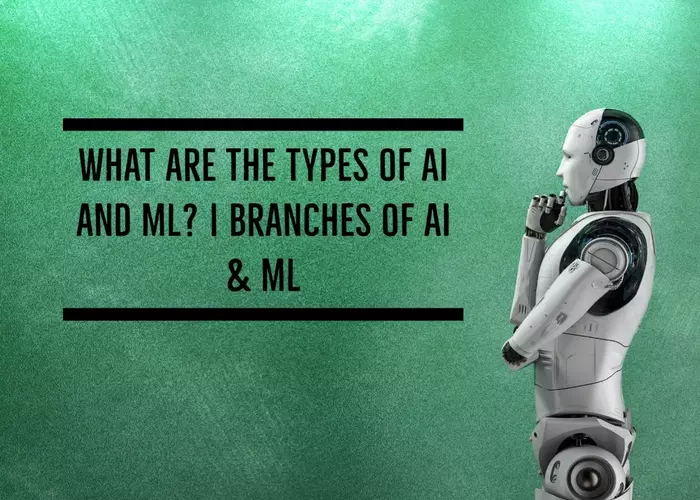Artificial Intelligence (AI) and Machine Learning (ML) are two of the most widely discussed and researched fields in technology today. Both are used to create intelligent systems that can learn, adapt, and perform tasks autonomously. However, there are several types of AI and ML, each with unique characteristics and applications. In this article, we will discuss types of artificial intelligence & ML, different branches of AI and ML, and their application areas. So, let’s start one by one.
Artificial Intelligence
“It is a branch of science and engineering by which we can create intelligent machines which can behave like humans, thinks like humans, and be able to make decisions.”
Types of AI
There are 4 types of artificial intelligence which are as follows:
- Reactive Machines: It is the most basic and simplest type of AI. They are not able to form memories or use past experiences to perform future decisions.
- Limited Memory: Limited memory AI is capable of learning from past experiences. This AI can store and use information from past events. The limited memory AI is capable of learning from past experiences.
- Theory of Mind: It is capable of understanding the thoughts, beliefs, and intentions of other entities. It is able to generate a mental model of the environment and make decisions based on it.
- Self-Awareness: This AI can understand its mental state and use this information to make decisions. It can make decisions based on its own knowledge and experience.
After going through the various types of AI, let’s proceed to the different branches of artificial intelligence.
Branches of AI
The branches are also known as AI programming, which is the practice of programming computers to replicate or simulate intelligent behavior. There are 4 different branches of AI which we are going to discuss below.
- Natural Language Processing (NLP): This branch focuses on developing computer systems that can understand, interpret, and generate natural language.
- Machine Learning: It involves the development of computer systems that can learn and improve automatically over time without being explicitly programmed.
- Computer Vision: This AI branch focuses on developing computer systems that can interpret, analyze, and manipulate digital images.
- Robotics: It focuses on developing computer systems that interact with physical environments.
Some other branches of AI include Expert Systems, Deep Learning, Neural Networks, Fuzzy Logic, Evolutionary Computing, Planning and Scheduling, and Automated Reasoning. However, AI is classified into two categories, which we will discuss next.
What are the 2 Categories of AI?
The two categories of AI are as follows:
- Weak AI (Narrow): This AI system is designed and trained to perform a specific task.
Examples- Image recognition software, Siri, Alexa, Google Assistant, etc.
- Strong AI (General): Strong AI is an intelligence system capable of learning any task assigned. It is a form of AI that can think and reason like a human being.
Examples- Self-Driving Cars, AI-driven chatbots, Automated trading platforms, etc.
After going through the branches and types of AI, let’s have a quick look at the applications of AI, which are generally searched on google.
Applications of Artificial Intelligence
Below are the following application areas of AI:
- Automated Customer Support: The AI can create automated customer support systems capable of answering customer queries, providing product information, and troubleshooting technical issues.
- Predictive Analytics: AI is used to predict future events or trends based on historical data. Applications include financial forecasting, customer behavior prediction, and fraud detection.
- Image Recognition: AI can be used to recognize images and objects in photos and videos. It is used for facial recognition, object identification, and other purposes.
- Autonomous Vehicles: Autonomous vehicles, also known as self-driving cars, use AI to navigate and drive without a human driver. This technology reduces traffic accidents and makes transportation more efficient.
- Healthcare: AI is used to diagnose and treat diseases, detect anomalies in medical scans, analyze patient data, and recommend treatments.
- Cybersecurity: AI can be used to detect and prevent cyber-attacks. This is done by analyzing network traffic and identifying suspicious patterns.
- Gaming: AI is used to create intelligent game characters that can learn and adapt to the player’s actions. Applications include video games, virtual reality, and augmented reality.
After discussing the various applications, branches, and types of AI, we proceed further to the machine learning types, branches, and application areas.
Machine Learning
“It is a sub-field or subset of AI that enable the computers to learn on their own. It gives computers the ability to learn without being explicitly programmed.”
Types and Branches of ML
There are several different types of machine learning, each with its own advantages and disadvantages. The following are some of the most commonly used types of ML:
- Supervised Learning: These learning algorithms learn from labeled data, where the desired output is already known. The model makes predictions based on this training data.
There are two types of supervised learning: Regression and Classification.
- Unsupervised Learning: Unsupervised learning algorithms learn from unlabeled data, where the desired output is not known. The model must find patterns or relationships in the data on its own.
There are two types of unsupervised learning: Clustering, Association. - Reinforcement Learning: Reinforcement learning algorithms learn from feedback and errors. It interacts with the environment and receives rewards when they achieve a certain goal.
- Semi-Supervised Learning: This is the fourth type of machine learning that combine elements of supervised and unsupervised learning, using a small amount of labeled data and a large amount of unlabeled data.
Now, it’s time to move on to some applications or uses of ML.
Machine Learning Applications
Following are the application areas of Machine Learning:
- Image and Pattern Recognition
- Text and Speech Recognition
- Healthcare Diagnostics
- Financial Trading
- Self-driving Cars
- Online Fraud Detection
- Product Recommendation
- Traffic and Weather Prediction
- Bioinformatics
- Surveillance System
Some other machine learning applications include generative models, Ad targeting, financial forecasting, and face recognition.
Final Thoughts
In conclusion, AI and ML are two of the most important and rapidly growing fields in technology today. There are many different types of AI and ML, each with its own unique characteristics and applications. Some most important branches of AI and ML include natural language processing, computer vision, robotics, deep learning, and reinforcement learning. As technology continues to advance, we can expect to see even more exciting developments in the field of AI and ML in the future.

Ankit Roy is a professional Technical Content Developer, Freelancer, and blogger. He holds a Masters’s degree in Computer Science and has worked as a Digital Marketing Strategist. With a deep understanding of technology trends like AI, ML, Big Data, Neural Networks, Network Infrastructure, etc., Ankit is able to communicate complex technical concepts in a clear and concise manner. He is a regular contributor to several websites and has authored numerous technical guides and instructional materials. In his free time, Ankit enjoys tinkering with new technologies and staying up-to-date with the latest developments in the field.




